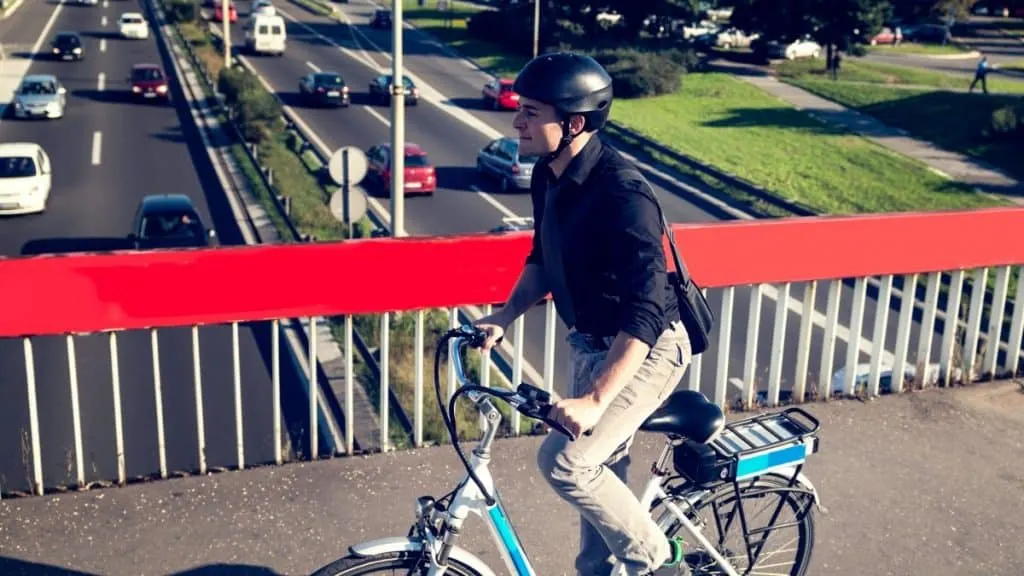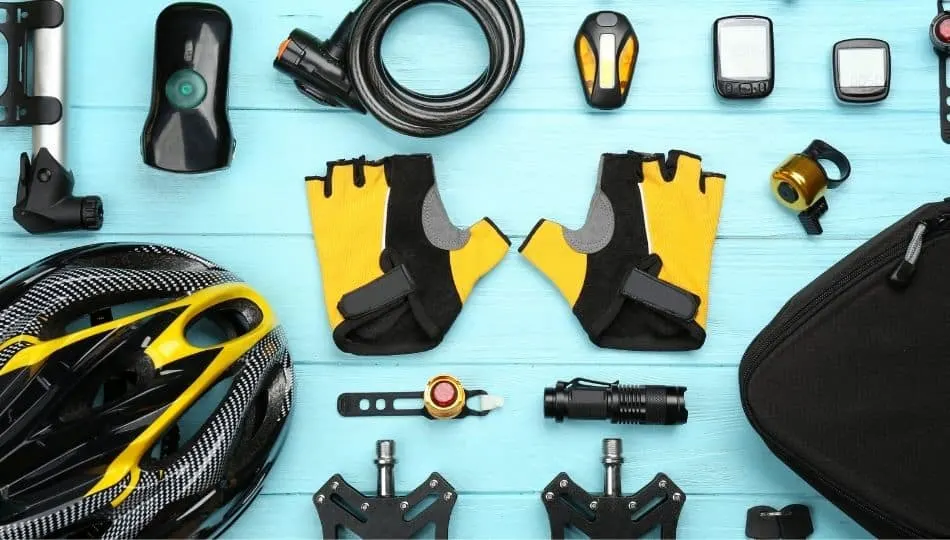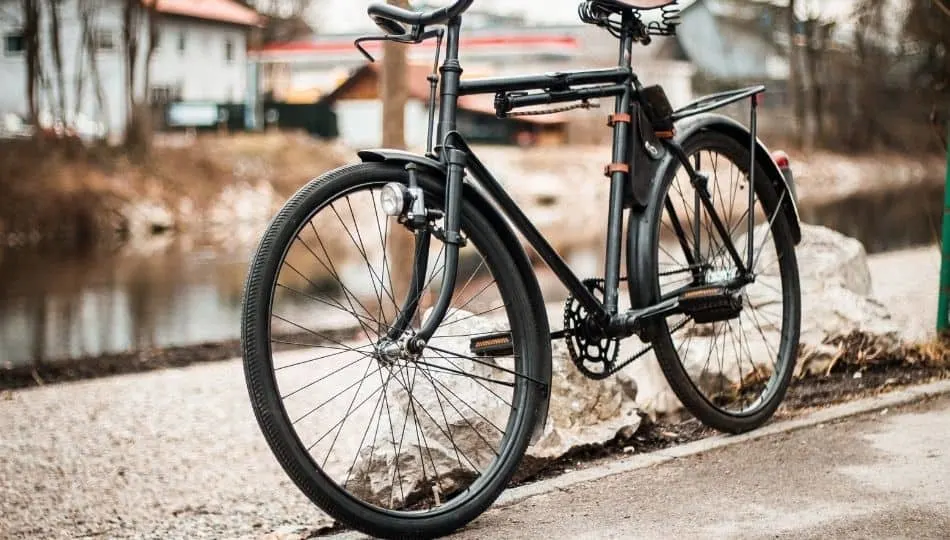
Cycling to work is a fantastic way to incorporate your daily dose of exercise with an easy form of transportation. However, it can be daunting if you don’t have a lot of experience or haven’t been on a bike for years.
Luckily there are things you can do to relieve your concerns and make the transition easier. Here are 6 Tips that will help make your cycling commute to work a stress-free and enjoyable daily experience.
Tip #1: Plan and Practice a Safe Route in Advance
You don’t want your cycling commute to work to be the first time you attempt a new route. So I recommend that you plan your route at least a few days before your first official cycling commute to work.
This will ensure you know exactly where you’re going before you leave and will reduce stress and your odds of getting lost.
Even if you think you know your surrounding area well, it is always best to practice your planned route before your first commute.
Not only will this increase your confidence that you know where you’re going and your route is efficient, but it will also help you determine various route details. These might include:
- How long it takes you to cycle the route
- How hard are you working on this route?
- Is this a high traffic route?
- Are there any obstacles along the way? (e.g. Passing a fire station or railroad tracks)
Determining these factors will help you decide if this is the best route for you. If you find you are working too hard for your abilities, it might be best to choose a different route, such as one with less inclines or hilly areas.
You can then work your way up to harder routes once you’ve had some more practice and experience.
Additionally, obstacles, such as railroad tracks, might pose an issue over time if you are constantly stopping for trains and late to work as a result.
NOTE: Sometimes things can come up during the commute that didn’t come up when you practiced your route, such as more traffic congestion. Which leads me on to my next point…
Tip #2: Allow Extra Time for the Unexpected
This is a good practice to have in any element of life, but it is certainly beneficial here. It is highly recommended that you leave for your cycling commute at least ten minutes earlier than however long your route takes you to arrive. This means, if your commute is a 20-minute ride, you should leave 30 minutes early.
Giving yourself a ten-minute head start allows time for any potential obstacles along your route, such as traffic or accidents, to ensure you won’t ever have to worry about being late to work.
It also helps you feel more relaxed during your ride so you can focus on enjoying the commute or on your exercise, rather than physically pushing yourself to the extreme to get to the office in time.
Tip #3: Kit up your Bike to Make your Bike Ride Easier
Regardless of your job, it is more than likely that cycling to work will require you to pack and transport your work supplies one way or another. These supplies might include a change of clothes, papers, books, your personal laptop, or other essentials.
A great way to conveniently carry all of your work materials is to accessorize your bike with storage equipment. Below is a list of some of the most beneficial and convenient bike accessories that are optimal for carrying all your work necessities.
QUICK TIP: Avoid using a backpack for your bike commute unless you have the opportunity to change your clothes/shower at work. A backpack will mean arriving to work with a back full of sweat that accrued during cycling!
Best Bike Accessories for Storage
Here’s a list of different types of bike accessories that can be used for storage. (All links in the list take you to the product on Amazon).
- Phone mount– Useful for directions when taking a new or emergency route
- Handlebar bag– Good for quick access to small necessities such as a wallet or keys
- Handlebar basket– Best for holding purses or small bags
- Rear luggage rack-Optimal choice for larger bags, briefcases, boxes, and other large or heavy cargo
- Bike panniers– Another great option to hook to the rear of your bike and hold ample amounts of belongings. You can store your work lunch in one bag and your materials in the other.
- Water bottle holder– Designed to clamp-on anywhere on the bike. Great for a refreshing drink of water, a workout boosting energy drink, or your morning coffee.

In addition to upgrading your bike with a series of accessories for travel convenience, a cycling backpack like this one on Amazon, is also a quality investment. This is great for clothes, shower products, or any precious materials you’d rather keep safe strapped to your back.
Remember, although these backpacks are great, you don’t want to weigh yourself down too much on your morning commute. Exercising will be easier and more effective when you don’t have excessive weight on your back, so if your cycling backpack starts to burden you, opt for one of the alternatives listed above.
Tip #4: Carry an Emergency Repair Kit
A great way to relieve any potential stress when cycling to work is to know with confidence that you’re prepared for any situation should something go wrong.
It is always recommended to have backup equipment and a backup plan so unforeseen circumstances don’t prevent you from getting to work on time.
One backup you should have on hand for your cycling commute is at least one spare tube, if not two, and any equipment you’ll need to fix a flat.
Same with owning a car, you’ll want to be prepared for a flat tire at any point just in case, and having this equipment on hand will assuredly put your mind at ease.
Having spare tubes is another reason why storage accessories come in handy.
You can also prevent flats by using full fenders for your bike if they are compatible with the type and model.
Another backup that you might be wary of obtaining, but is highly recommended, would be an additional bike. Although this could be a hefty investment, especially considering the cost of cycling equipment alone, having a spare bike is extremely helpful when your primary bike breaks or wears down.
Additionally, it is always beneficial to have various bikes tailored to different types of terrain and exercise. Having a second bike might help you shake-up your cycling routine by allowing you to create more routes for your commute.
One bike could be dedicated to roads for city or town routes, and the other could be dedicated to trails for routes through the woods or the park.
Finally, make sure you have a plan B for when you just can’t ride your bike to work. This might be due to weather, an injury, difficulties with equipment, or various other reasons.
Regardless, you’ll want to be sure that in the worst-case scenario where you can’t cycle to work, you still have a reliable alternative. Some examples would be the bus, train, a carpool buddy, or a payable car service such as a taxi or Uber.
Tip #5: Check the Weather Beforehand
For many people, their cycling commute to work is the starting point of their day, and you don’t want to start your day on a sour note by getting dowsed in the rain when you aren’t wearing the proper clothing or equipment for such conditions.
When cycling, you’re more easily exposed to the elements than other forms of transportation, so you’ll want to be vigilant of the weather to ensure you are appropriately prepared or that it is even safe to cycle to work that day.
Be sure to keep an eye on the weather through weekly forecasts and then check it again the night before your commute and in the morning before leaving. Although forecasts can never 100% guarantee the weather, it is best to be as informed as possible in this regard.
Tip #6: Invest in Equipment
As is the case with any form of exercise or transportation, you’re going to need to invest in some proper equipment at one point or another to perform efficiently. When it comes to cycling, there are two essential pieces of equipment, apart from storage accessories, and you’ll want to seriously consider investing in the best of the best. These essentials are clothing and your bike.
Cycling Clothing
Your clothing is one of the most essential investments in cycling because it can make or break your experience in terms of comfort. If you aren’t wearing the proper cycling clothing, you’re far more likely to chaff, overheat, be too cold, sweat more profusely, or even injury yourself.
You never want to wear your work get-up on your cycling commute. You will undoubtedly ruin it with sweat, and it will be extremely uncomfortable. Instead, invest in light, breathable, and waterproof clothing, particularly for a jacket and pants. You’ll also want padded underwear and biking gloves for increased comfort.
Cycling Bike
That Walmart bike you bought for $100 might get you from point A to point B, but it is far more likely that this will be a painful and long commute because these are cheap pieces of equipment that aren’t built for frequent commuters and serious cycling.

To prevent injuries, reduce commute time, and increase exercise productivity, you’ll need to invest in a quality bike. These bikes are typically pricy, but this is the most worthwhile investment if you are serious about cycling to work on a daily basis. Below are some of the top hybrid bikes for commuters.
- Pinnacle Lithium 3 2020 Men’s Hybrid bike
- Specialized Sirrus 2.0
- Trek Domane AL 2
Be sure your bike is conducive to your commuter route in terms of terrain and your cycling level before investing in a hefty purchase.
How Long Does It Take for Cycling to Get Easier?
When asked the same question, renowned American cyclist Greg Lemond once responded, “It never gets easier, you just get faster.” This quote has been a strong motivator for individuals of the cycling community because, for better or worse, he’s right.
Cycling isn’t about getting “easier.” Yes, over time, with dedication, practice, and perseverance, your legs will become stronger, your endurance will increase, and routes that once had you gasping for air will be a breeze.
Cycling isn’t just a convenient way to get to work every morning; it’s a sport. A physical test you put your body through every day to push your limits and see how far you can go.
So, does it get easier? Certainly, if you let it. You’ll undoubtedly reach a point in physical fitness weeks or even months after starting your cycling journey where you can resign yourself to the now easy level you started at.
However, we strongly recommend exploring yourself and this sport by constantly (but safely) increasing your speed and difficulty and creating new cycling goals for consistent motivation and a source of personal achievement.
